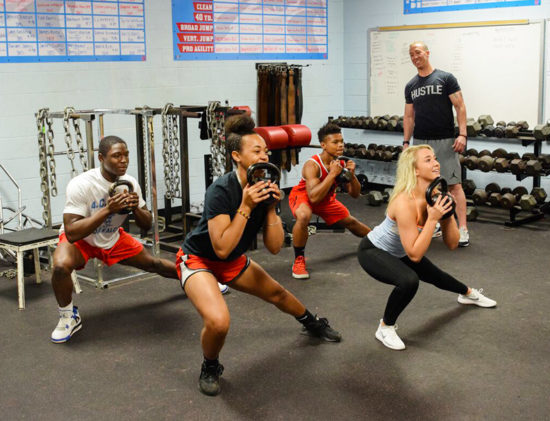Mental keys to athletic improvement and achievement
Doubt in an individual’s mind is the cancer that kills dreams and prevents individuals from pursuing and achieving their ambitious goals.
 Dream big. Starting quarterback. All-state. College scholarship. Academic All-American. Professional career. Encourage your student-athletes to set big goals that might be a bit intimidating.
Dream big. Starting quarterback. All-state. College scholarship. Academic All-American. Professional career. Encourage your student-athletes to set big goals that might be a bit intimidating.
By shifting one’s focus from major milestones and comparative status labels to the simple, ever-changing target of maximizing one’s own potential, we allow our student-athletes to remove the doubt associated with whether a goal is possible and focus on something that’s realistic. That is being our personal best.
Focusing on maximizing individual potential also accomplishes something that’s counterintuitive. By removing set numbers, destinations and ceilings, a student-athlete can dream even bigger goals (the student-athlete may have the potential to be a hall of famer instead of just another pro). Many goals equate to a destination that needs to be moved upon accomplishing the goal, but maximizing one’s potential is a lifelong pursuit with mere milestones along the way.
Being the best one can be affords that person with a realistic goal of doing as much as they can to get better each and every day. Focusing on improving in the present while pursuing an ambitious goal allows the student-athlete to enjoy the process of practice and sacrifice. This also allows the student-athlete to live with no regrets so long as they can look back on their athletic career knowing that they did everything they could to maximize their potential.
Here are seven rules for success and achievement that any coach can teach their student-athletes.
1. Chase your dreams and your passions.
Make sure your goals align with daily activities that you enjoy and care about. If you’re not passionate about your craft and determined to pursue your goals, then best-case scenario is that you will quit. Worst-case scenario is that you spend years of hard work pursuing a goal only to obtain it and realize that you don’t really want it.
2. Surround yourself with people you want to be like.
Author Jim Rohn tells us, “You are the average of the five people you spend the most time with.” If you need to improve your work ethic, surround yourself with friends who are motivated. If you need to be more positive, find someone who is happy-go-lucky.
To accomplish something great, you must be willing to be different than others. You cannot let everyone else negatively influence you or distract you from what’s important. Surrounding yourself with good influences is directly related to effective use of your time. Individuals in your circle need to contribute value to you, and you need to bring value to the people in your circle.
 3. Focus on what you can control.
3. Focus on what you can control.
You control the following: your work ethic, your attitude and how you treat others. Don’t stress about what you cannot control.
4. Set big goals, but focus on maximizing your own potential.
The end goal is a byproduct of the daily work necessary to reach that goal. Become the best at getting better.
5. Embrace discomfort.
Comfort is the enemy of growth. If achieving a goal is easy, everyone would obtain that achievement and it wouldn’t be worth sacrificing for. Between goals and achievement is discipline and consistency.
6. Don’t share your goals with those who won’t support, encourage and help you.
Sharing goals is an intimate thing. You should not share them unless you know the person supports you, or you’re determined enough not to care when people tell you your goal is impossible. The vast majority of people have given up on their dreams, and many of them don’t want to see you achieve your dream.
7. Repeat rule No. 1.
By learning how to chase your dream and pursue your passions, you succeed on a daily basis. You repeatedly find success in your life. Your athletic and academic career will come to an end at some point, but if you know how to chase your dreams, you will be ready to succeed in whatever excites you next in life.
Micah Kurtz (MS, CSCS, RSCC*D, FMS, USAW, NASE-CSS) was named the 2016 National Strength Coach of the Year by the NSCA. He is in his ninth year as the director of strength, conditioning and athletic development at AC Flora High School and serves as the strength and conditioning consultant coach to the nine-time high school basketball national champs, Oak Hill Academy. Luke Kurtz is the vice president of legal affairs for U.S. Sugar. He played and coached professional football for the Corinthians football club in São Paulo, Brazil. Learn more at www.TheAthleteMaker.com.
Steps to writing an individual development plan
A goal without a plan is a prelude to disappointment. Many individuals know what they want, but they don’t know how to achieve it. Others don’t even know what they want and wander aimlessly through life, or they chase goals that they ultimately don’t care about.
Athletes are often told to set goals, but rarely do we teach our student-athletes how to achieve them. An individual development plan provides a map for pursuing what you’re passionate about.
To help your student-athletes develop an individual development plan, ask them to follow these four steps:
- Find your north star by determining what excites and motivates you. When your mind wanders, what do you think about? This forces the individual to focus on what they’re truly passionate about and provides direction for those who are lost.
- Identify the long-term goal. This is the big, scary goal. A goal that you’re afraid to say out loud because you the odds of achieving it, and you don’t want others to think you’re arrogant. Or, you don’t speak about it because you think people will laugh.
- Identify your strengths and weaknesses. How can you enhance and capitalize on your strengths to move closer to your long-term goal? What skills (competencies) need to improve in order to achieve your goal? What can you do to improve in areas of weakness? Consider what areas you will develop first, second and third. What will look different when this skill (competency) is fully developed? What will you be able to do that you can’t do today?
- List short-term goals that put you in a better position to reach your long-term goal. These goals are relatively achievable, near terms and under your control. For example, “I’m going to take 500 jump shots five days a week.” After accomplishing each short-term goal ask yourself, “How will I be better, and how can I build on my new capability to move closer to achieving my ultimate goal?”





